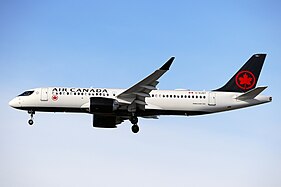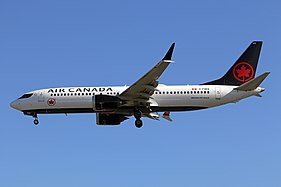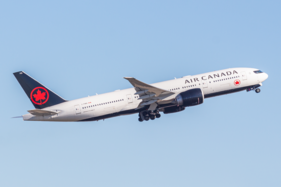Air Canada fleet

As of December 2023[update], the Air Canada fleet consists of 187 mainline passenger aircraft, a mix of Airbus and Boeing narrow-body and wide-body jets.
Additionally, Air Canada's various brands each have smaller fleets. Air Canada Cargo operates a fleet of seven Boeing 767-300F freighter aircraft, Air Canada Express has a fleet of 50 turboprop aircraft and 67 regional jets, Air Canada Jetz operates four Airbus A320 aircraft in an all-Business class configuration, and leisure brand Air Canada Rouge has 40 jets from the Airbus A320 family of narrow-body aircraft.
Current fleet[edit]
This section only covers Air Canada's mainline passenger fleet. It does not include the fleets of Air Canada Cargo, Air Canada Express, Air Canada Jetz or Air Canada Rouge.
| Aircraft | In service | Orders | Passengers | Notes | |||
|---|---|---|---|---|---|---|---|
| J | W | Y | Total | ||||
| Airbus A220-300 | 33 | 27[2] | 12 | — | 125 | 137 | Deliveries until 2026.[3] Order with 15 options.[3] |
| Airbus A319-100 | 3 | — | 14 | — | 106 | 120 | |
| 2 | 12 | 124 | 136 | Aircraft transferred from and still in Air Canada Rouge configuration. | |||
| Airbus A320-200 | 19 | 2 | 14 | — | 132 | 146 | 8 aircraft to be retrofitted by 2025.[4] |
| Airbus A321-200 | 14 | — | 16 | — | 174 | 190 | All aircraft to be retrofitted to 196 seats by 2025.[4] |
| 2 | 180 | 196 | |||||
| Airbus A321XLR | — | 30 | 14 | — | 168 | 182 | Deliveries from Q3 2025 to 2029.[5][6][7] |
| Airbus A330-300 | 16 | 1 | 32 | 24 | 241 | 297 | To be delivered in 2024.[8] |
| 2 | — | 30 | 255 | 285 | |||
| Boeing 737 MAX 8 | 40 | 5 | 16 | — | 153 | 169 | |
| Boeing 777-200LR | 6 | — | 40 | 24 | 236 | 300 | |
| Boeing 777-300ER | 12 | — | 40 | 24 | 336 | 400 | |
| 7 | 28 | 398 | 450 | ||||
| Boeing 787-8 | 8 | — | 20 | 21 | 214 | 255 | |
| Boeing 787-9 | 31 | 1 | 30 | 21 | 247 | 298 | Deliveries until 2024.[3] |
| Boeing 787-10 | — | 18 | TBA | Deliveries begin late 2025.[9] | |||
| Heart ES-30 | — | 30 | — | — | — | 30 | Deliveries begin 2028.[10] |
| Total | 195 | 114 | |||||
Gallery[edit]
- Hover over each photo to view label detail
-
Airbus A319-100 in older livery
Historical fleet[edit]
This article needs additional citations for verification. (March 2023) |
- Air Canada's Douglas DC-8-63 fleet was withdrawn from passenger service in 1983. Six of these were converted to DC-8-73F freighters in 1984 and retained for use by Air Canada Cargo eventually being sold off between 1990 and 1994.
- Air Canada's Douglas DC-9-15s were used up to 1968. One DC-9-32CF was used for cargo flights until 1977. The McDonnell Douglas DC-9-32s were used from 1967 to 2002.
- Air Canada's Canadair CRJ-100 aircraft were used from the mid 1990s until the early 2000s when they were transferred to regional affiliate Jazz Air LP operating as Air Canada Jazz.
- Air Canada's Airbus A340-500s were retired in November 2007 and replaced by Boeing 777-200LRs.[11]
- Air Canada's Airbus A340-300s were retired in November 2008 and replaced by Boeing 777-300ERs.[12]
- Air Canada's Boeing 767-200ER fleet was retired from service by the end of 2008.
- The McDonnell Douglas DC-10-30 aircraft were operated from 1979 to 2000 by Canadian Pacific Air Lines and its successors Canadian Airlines International.
- The Boeing 737-200 aircraft were operated from 1968 to 2000 by Canadian Pacific Air Lines and its successors Canadian Airlines International. Subsequent to the merger with Canadian Airlines International, Air Canada operated these aircraft in a mainline two-class configuration, as well as in an all-economy class configuration with the Air Canada Tango and the Zip low-cost carrier brands.
- In 2020, Air Canada retired their entire Embraer E190 and Boeing 767-300ER fleets. The Embraer E190s were replaced by the Airbus A220-300 and Boeing 737 MAX 8, while the Boeing 767-300ER was replaced by the Airbus A330-300 and Boeing 787s. As of December 2021, certain previously retired Boeing 767-300ER (legacy passenger variant) aircraft are being converted and reintroduced into the fleet as Boeing 767-300ER/BDSF cargo aircraft.[13]
- Air Canada additionally planned to completely retire its Airbus A319 fleet in May 2020, replacing them with further Airbus A220-300s. The mainline A319s were tentatively retired later than previously planned on February 7, 2021, with the final mainline A319 operating a flight from Calgary to Phoenix; however, Air Canada continued to operate A319s as part of its charter fleet under Air Canada Jetz. Subsequently, mainline A319 service resumed in March 2022. As of September 2023, Air Canada operates 5 A319s as part of its mainline fleet.
Aircraft that Air Canada has operated since 1937, but are no longer in the fleet:
| Aircraft | Total | Introduced | Retired | Notes | Refs |
|---|---|---|---|---|---|
| Airbus A340-300 | 13 | 1995 | 2008 | Replaced by Boeing 777-300ER. | [14] |
| Airbus A340-500 | 2 | 2004 | 2007 | Disposed to TAM Airlines. Replaced by Boeing 777-200LR. |
[14] |
| Avro Lancastrian | Unknown | 1943 | 1947 | [14] | |
| BAe 146-200 | 5 | 1990 | 2005 | Operated by Air BC. | [14] |
| 5 | Operated by Air Nova. | ||||
| Boeing 727-200 | 30 | 1974 | 1992 | [14] | |
| Boeing 737-200 | 44 | 1976 | 2004 | Taken over from merged Canadian Airlines International. | [14] |
| Boeing 747-100 | 5 | 1971 | 1998 | [14] | |
| Boeing 747-200M | 3 | 1975 | 1999 | [14] | |
| Boeing 747-400 | 4 | 1990 | 2004 | Taken over from merged Canadian Airlines International. Fleet sold to Aerolineas Argentinas and Philippine Airlines due to Air Canada's 2003 bankruptcy caused by the 9/11 attacks.[15] |
[14] |
| Boeing 747-400M | 3 | 1990 | 2004 | Fleet sold to Air India, Air Cargo Global, and Guggenheim Aviation Partners due to Air Canada's 2003 bankruptcy caused by the 9/11 attacks.[15] | [14] |
| Boeing 767-200 | 23 | 1983 | 2008 | C-GAUN, nicknamed Gimli Glider, was also in service until 2008. | [14] |
| Boeing 767-300ER | 44 | 1988 | 2020* | 23 aircraft taken over from merged Canadian Airlines International. 25 aircraft transferred to Air Canada Rouge. Fleet replaced by Boeing 787-9 and Airbus A330-300. *Certain aircraft are being reintroduced into the fleet as Boeing 767-300ER/BDSF cargo aircraft.[13] |
[14] |
| Bombardier CRJ100 | 26 | 1994 | 2002 | Transferred to Jazz Aviation. | |
| Bristol Freighter | Unknown | 1953 | 1955 | [14] | |
| Canadair North Star | Unknown | 1946 | 1961 | [14] | |
| Douglas DC-3 | Unknown | 1945 | 1963 | [14] | |
| Douglas DC-8-40 | 11 | 1974 | 1979 | [14] | |
| Douglas DC-8-50 | 3 | 1968 | 1980 | [14] | |
| Douglas DC-8-50CF | 7 | 1964 | 1985 | [14] | |
| Douglas DC-8-60 | 14 | 1970 | 1986 | CF-TIW, operating as Air Canada Flight 621, crashed while attempting a second landing at Toronto. Premature deployment of the spoilers on the first attempt resulted in a hard landing and structural damage. | [14] |
| Douglas DC-8-70F | 8 | 1974 | 1994 | [14] | |
| Embraer E175 | 15 | 2005 | 2013 | Launch Customer, Transferred to Sky Regional Airlines. | |
| Embraer E190 | 45 | 2005 | 2020 | Aircraft were leased to Nordic Aviation Capital and were later on sold to Breeze Airways. Fleet replaced by Airbus A220-300. | [14][16] |
| Fokker F28 Fellowship | 30 | 1986 | 2004 | Operated by Canadian Regional Airlines. | [14] |
| Lockheed L-1011 TriStar Series | 18 | 1973 | 1999 | Fleet replaced by Boeing 767-300ER. Initially retired in 1991. Three aircraft returned to service through 1999.[17] |
[14] |
| Lockheed L-1049 Super Constellation | Unknown | 1953 | 1963 | [14] | |
| Lockheed Model 10 Electra | Unknown | 1937 | 1941 | [14] | |
| Lockheed Model 14 Super Electra | Unknown | 1941 | 1949 | [14] | |
| Lockheed Model 18 Lodestar | Unknown | 1941 | 1949 | [14] | |
| McDonnell Douglas DC-9-10 | 14 | 1966 | 1981 | [14] | |
| McDonnell Douglas DC-9-30 | 50 | 1967 | 2002 | C-FTLU caught fire as Flight 797 in 1983 at Cincinnati/Northern Kentucky International Airport. | [14] |
| Stearman 4-EM Senior Speedmail | Unknown | 1937 | 1939 | [14] | |
| Vickers Viscount | 51[18] | 1955 | 1974 | 15 – model V.724, 36 – model V.757[19] | [14] |
| Vickers Vanguard | 23 | 1961 | 1972 | 23 – Type 952 | [14] |
British Aerospace 146-200 and Fokker F28 jet aircraft were operated by regional airline affiliates of Air Canada via code sharing agreements.
References[edit]
- ^ "Air Canada Fleet Details and History". Planespotters.net. 19 December 2023. Retrieved 19 December 2023.
- ^ "Air Canada to Acquire 15 Additional Canadian-built Airbus A220-300 Aircraft". aircanada.com. 2022-10-26. Retrieved 2022-10-26.
- ^ a b c "Third Quarter 2022 Management's Discussion and Analysis of Results of Operations and Financial Conditions" (PDF). 28 October 2022. Retrieved 28 October 2022.
- ^ a b Canada, Air. "Air Canada Unveils First Upgraded Airbus A321 with an All New Interior and Industry-Leading Cabin Technology". www.newswire.ca. Retrieved 2023-10-23.
- ^ "Air Canada Announces the Acquisition of 26 Airbus A321neo Extra-Long Range Aircraft". 22 March 2022. Retrieved 22 March 2022.
- ^ "Air Canada Reports First Quarter 2022 Financial Results". aircanada.com. 26 April 2022. Retrieved 30 April 2022.
- ^ "Third Quarter 2023 Management's Discussion and Analysis of Results of Operations and Financial Conditions" (PDF). 30 October 2023. Retrieved 30 October 2023.
- ^ https://filecache.investorroom.com/mr5ircnw_aircanada/532/Q4_2023_Air_Canada_MDA.pdf
- ^ "Air Canada to Acquire 18 Boeing 787-10 Dreamliner Aircraft under ongoing Fleet Renewal and Fuel Efficiency Drive". Air Canada. Retrieved 2023-09-25.
- ^ Air Canada to Acquire 30 ES-30 Electric Regional Aircraft from Heart Aerospace. aircanada.com. 15 September 2022. Retrieved 6 May 2023.
- ^ "PlaneRegister.com – Air Canada historical Airbus A340". Planesregister.com. Archived from the original on 15 July 2011. Retrieved 21 February 2011.
- ^ "Air Canada Fleet of A340 (History) – Airfleets aviation". Airfleets.net. Retrieved 21 February 2011.
- ^ a b "Air Canada Cargo Announces Launch Routes For its Newly Converted Freighter Aircraft Arriving This Fall". Air Canada (Press release). 14 June 2021. Retrieved 31 December 2021.
- ^ a b c d e f g h i j k l m n o p q r s t u v w x y z aa ab ac ad ae af Air Canada Historical Fleet Date accessed: 27 January 2009
- ^ a b "What Happened to Air Canada's Boeing 747s?". 28 September 2020.
- ^ "Air Canada Reports First Quarter 2020 Results".
- ^ "Maple Tristars: Air Canada L-1011s".
- ^ Tenby, Henry (9 March 2019). "Air Canada Retires the Vickers Viscount April 27, 1974 – End of An Era". HenryTenby. Archived from the original on 1 April 2023. Retrieved 2023-06-12.
- ^ "A Virtual Museum dedicated to the Vickers-Armstrongs Viscount". Vickers Viscount Museum. Retrieved 2023-06-12.










